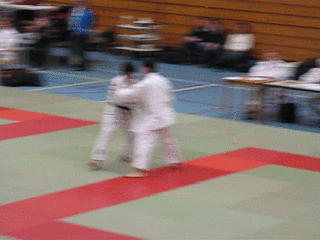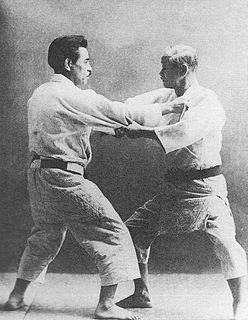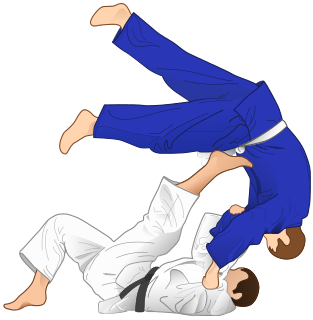In Japanese martial arts, the term atemi (当身) designates blows or strikes to the body, as opposed to twisting of joints, strangleholds, holding techniques and throws. Atemi can be delivered by any part of the body to any part of the opponent's body. They can be percussive or use "soft" power. Karate is a typical martial art focusing on percussive atemi. The location of nerve and pressure points, such as might be used for certain acupressure methods, also often informs the choice of targets for atemi.

Seoi nage (背負い投げ) is a shoulder throw, one of the traditional forty throws of Judo as developed by Jigoro Kano. It belongs to the first group, Dai Ikkyo, of the traditional throwing list, Gokyo, of Kodokan Judo. It is also part of the current 67 Throws of Kodokan Judo. It is classified as a hand technique, te-waza, and is the second throw performed in the Nage-no-kata.

Kata guruma (肩車) is one of the traditional forty throws of judo as developed by Kano Jigoro. Kata guruma belongs to the third group of the traditional throwing list in the Gokyo no waza of the Kodokan Judo. It is also part of the current 67 Throws of Kodokan Judo. Because the technique is not a sweep nor a trip and requires tori to pull uke into a carry, it is categorized as a hand throwing technique (tewaza).
Katame no Kata is one of the two Randori-no-kata of Kodokan Judo. It is intended as an illustration of the various concepts of katame-waza that exist in judo, and is used both as a training method and as a demonstration of understanding.

Ju no Kata is a kata in Judo. It is designed to teach the fundamental principles of judo, especially the principle of ju . It consists in three sets of techniques and is performed by a pair of people one acting as an Uke and the other a Tori. The kata can be performed without wearing a judogi and, as it doesn't involve the completion of any throws, does not need to be performed in a dojo.

Koshiki no Kata is a kata in Judo. It is also known as Kito-ryu no Kata. It consists of 21 techniques originally belonging to the Takenaka-ha Kito School of jujutsu. Jigoro Kano revised the techniques and incorporated them into a kata in order to preserve the historical source of judo. The set of forms is antique and were intended for "Kumiuchi", the grappling of armored warriors in the feudal ages. As such, the kata is to be performed with both partners imagining that they are clad in armor. The Koshiki-no-kata, together with Nage-no-kata, Katame-no-kata, Ju-no-kata, Kime-no-kata and Goshin-Jitsu, is recognised by the International Judo Federation (IJF.) Although koshiki-no-kata is not often seen in the United States, it is still taught and practiced in Japan. Some striking demonstrations of it from the 1950s can be seen in the film "Classic Judo Kata," by Harold Sharp. If the description of the kata in that film is correct, it would be the only judo kata that involves attacking the cervical spine.

Uki Goshi (浮腰) is one of the original 40 throws of Judo as developed by Jigoro Kano. It belongs to the first group, Dai Ikkyo, of the traditional throwing list, Gokyo, of Kodokan Judo. It is also part of the current 67 Throws of Kodokan Judo. It is classified as a hip technique, Koshi-Waza. Uki goshi is known as a favorite throw of Jigoro Kano himself. It is demonstrated in the Nage no Kata. It used to be much drilled in traditional judo dojos.

Ō goshi is one of the original 40 throws of Judo as compiled by Jigoro Kano.

Sukui Nage (掬い投) is a double leg takedown, one of the original 40 throws of Judo as developed by Jigoro Kano. It belongs to the fourth group, Yonkyo, of the traditional throwing list, Gokyo, of Kodokan Judo. It is also part of the current 67 Throws of Kodokan Judo. It is classified as a hand technique, Te-waza.

Yoko Guruma (横車), is one of the original 40 throws of judo as developed by Jigoro Kano. It belongs to the fifth group, Gokyo, of the traditional throwing list, Gokyo, of Kodokan Judo. It is also part of the current 67 throws of Kodokan Judo. It is classified as a side sacrifice technique, Yoko-sutemi. This technique is considerably difficult to perform, and can be used as either a direct attack or a counter. In classical study of nage-waza, it is preferable to use it as a counter throw to seoi-nage.

Ura Nage (裏投) is one of the original 40 throws of Judo as developed by Jigoro Kano. It belongs to the fifth group, Gokyo, of the traditional throwing list, Gokyo, of Kodokan Judo. It is also part of the current 67 Throws of Kodokan Judo. It is classified as a rear sacrifice technique, Ma-sutemi.

The Canon of Judo is a book that was originally published in 1956, and written by Kodokan 10th dan, Kyuzo Mifune (1883-1965). The book covers almost all of the Kodokan recognized techniques, adds variations and new techniques, including Do-Jime in passing as well. The book also describes fifteen Kata developed by Mifune to teach adaptation through reversal and counters. The book organizes the techniques differently from the official Kodokan Gokyo.
The Nage-waza ura-no-kata is a judo kata that, like the Gonosen-no-kata, focuses on counter-attacks to throwing techniques. It was developed by Mifune Kyūzō, and is not an officially recognized Kodokan kata.
Tsubame Gaeshi (燕返し) is a Judo throw that falls within the seventeen techniques of the Shimmeisho no waza, officially recognised by the Kodokan in 1982. Literally translated as "Swallow Counter", Tsubame gaeshi is the countering of an ashi waza with Deashi harai from the opposite leg. A right-handed Deashi-harai executed by uke, for instance, would be avoided by tori bending his right knee, followed by a left-handed Deashi-harai. Tsubame gaeshi as a counter against uke's Deashi harai is the opening move of the Kaeshi-no-kata. As a counter against Okuriashi harai, it forms the sixth technique of the Nage-Waza-Ura-no-kata.
Atemi Ju-Jitsu, in Japanese: Atemi (当て身) Jujutsu (柔術), also called Pariset Ju-Jitsu, was established in France in the 1940s by the late Judo and Ju-Jitsu legend Bernard Pariset to revive and preserve old martial techniques inherited from Feudal Japan. The Pariset family is sometimes referred to as the 'French Gracie', after having developed their own self-defense Jujitsu style directly inspired from the original Kano Jiujutsu and older koryū jujutsu systems developed to train Samurai warriors for defeating an armed and armored opponent on the battlefield. The Pariset family studied directly with Mikonosuke Kawaishi, his assistant Shozo Awazu, and Minoru Mochizuki. Kawaishi was a student of Jigoro Kano - founder of Judo, and Mochizuki was a student of Jigoro Kano, Gichin Funakoshi and Morihei Ueshiba - founders of Shotokan Karate and Aikido respectively.
The Katame-waza ura-no-kata is a judo kata that can be considered as a complement to Mifune Kyūzō's Nage-waza ura-no-kata, but that instead focuses on counter-attacks to controlling techniques rather than throwing techniques. It was compiled by Itō Kazuo from techniques developed by other Japanese newaza experts, and is not an officially recognized Kodokan kata.
Atemi waza (当て身技) or body-striking techniques were the strikes from the several ancient traditional Japanese jujitsu styles that were adopted in judo by its designer Jigorō Kanō in 1882 after a comprehensive study, accompanied by uke waza or defending blocks and parries. When judo further developed as a sports discipline, these techniques were excluded from its competition repertoire, which limits itself mainly to throws and holds : although taught within self-defense, kata and sometimes used within informal randori, striking techniques are forbidden in the sport judo competitions rules.












